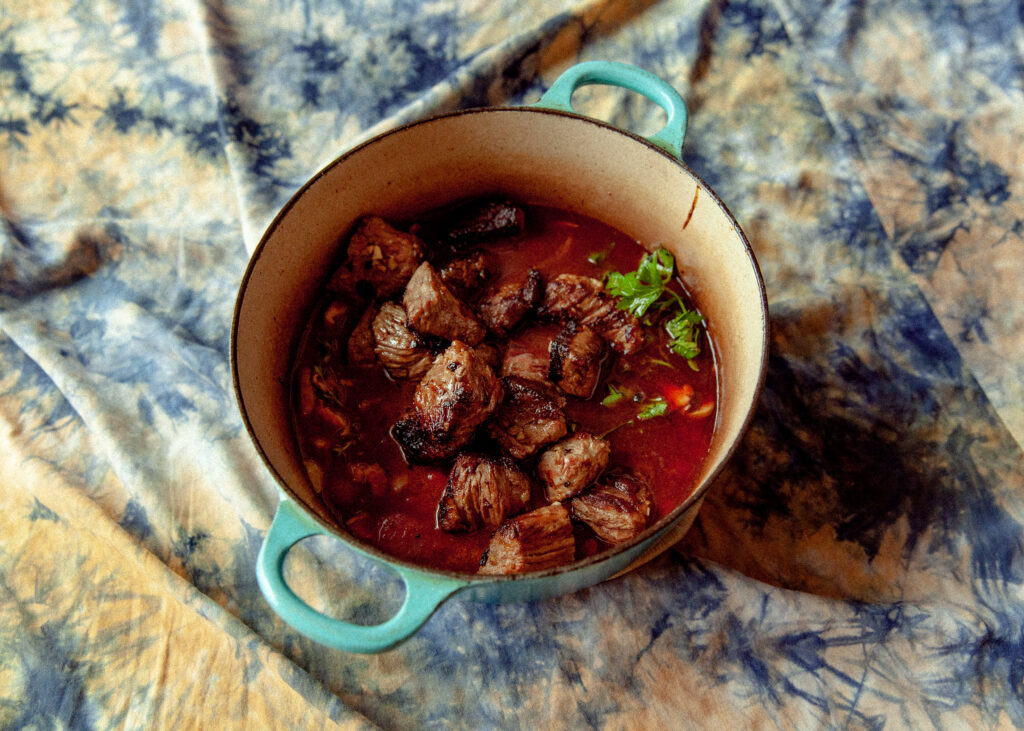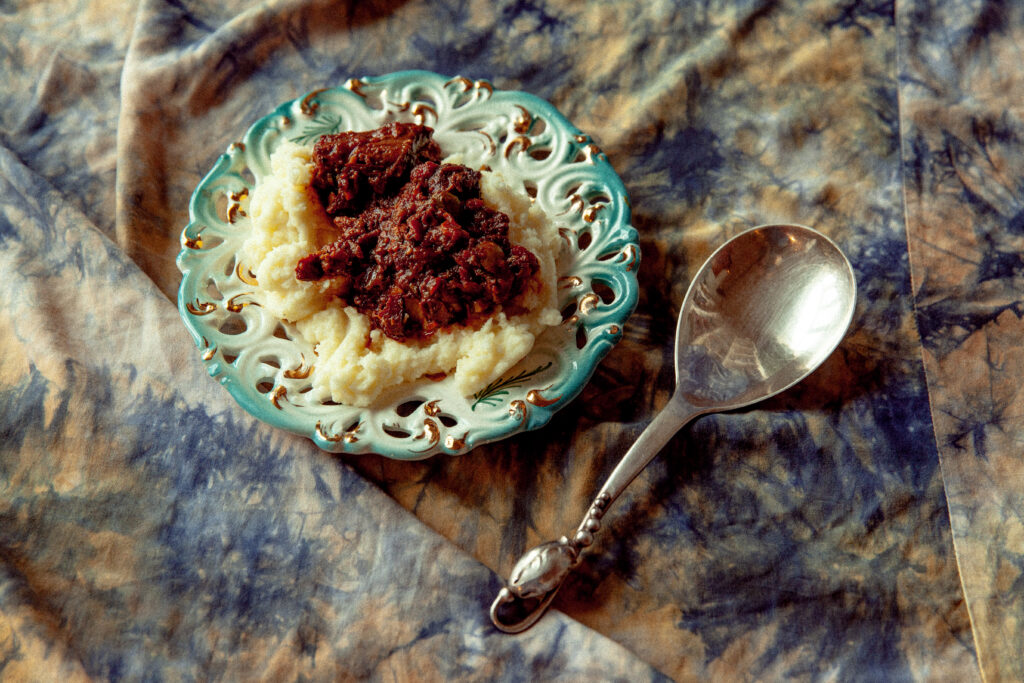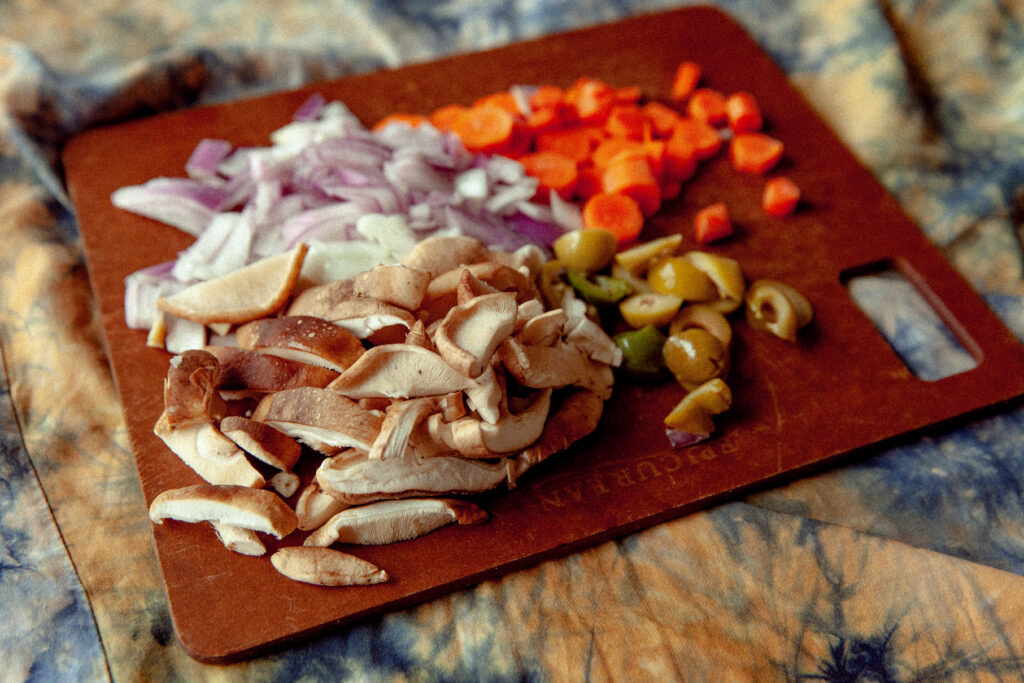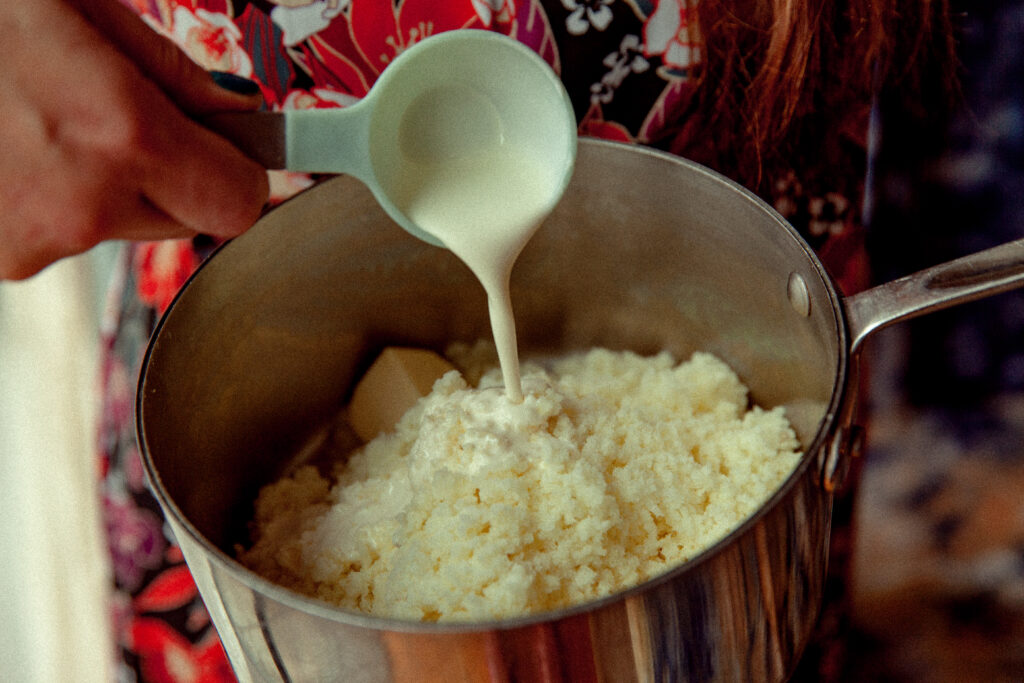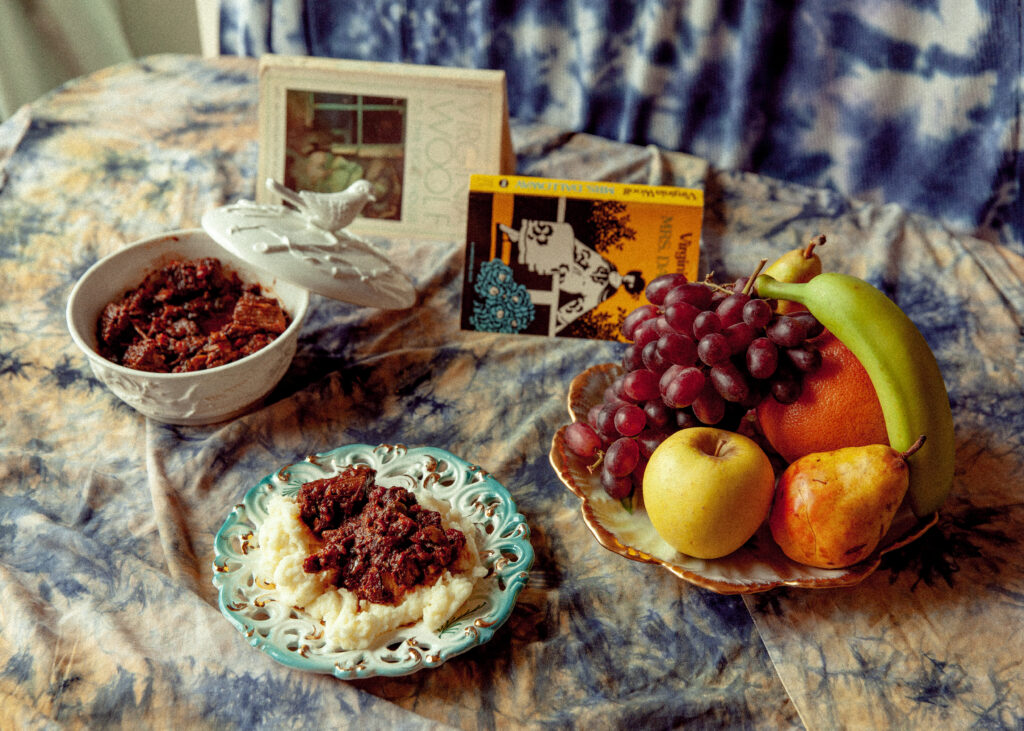Cooking with Virginia Woolf
The boeuf en daube in To the Lighthouse, a 1927 novel by Virginia Woolf about an English family on vacation in the Hebrides, is one of the best-known dishes in literature. Obsessed over for many chapters by the protagonist, Mrs. Ramsay, and requiring many days of preparation, it is unveiled in a scene of crucial significance. This “savory confusion of brown and yellow meats,” in its huge pot, gives off an “exquisite scent of olives and oil and juice.” It serves as a monument to the joys of family life and a celebration of fleeting moments. Thus, it is with fear and trembling that I suggest that Woolf’s boeuf en daube, from a cook’s perspective, is a travesty, and that its failures may prove instructive.
First, it should be said that absolutely nothing else is wrong with To The Lighthouse, a masterpiece that stands out even among Woolf’s many masterpieces. On its shimmering surface, the story concerns a few hazy-blue, sun-soaked September days in a big rambling house by the sea, and what those days mean for the people gathered there. There’s a selfless mother, an egotistical father, and eight children, plus guests, including a young painter, an old poet, and a couple newly engaged. Their concerns are ordinary ones: Will Minta and Paul Rayley be happy together? Will the planned expedition to the lighthouse come off? Will the boeuf be perfect, as the hostess hopes? But Woolf’s true purpose is to evoke the great shifting mass of consciousness, and to locate each character’s purpose therein. What is each one doing here? How do they relate to each other? “What was the value, the meaning of things?”
She succeeds so spectacularly that some readers have perceived a mystical presence in the book. Eudora Welty, in my copy’s introduction, writes that Woolf’s “conception has the strength of a Blake angel” with “streaming hair and muscles stretched.” Her rapture is understandable. Woolf’s descriptions of what the characters see captures the subjective ways in which we see; the braided flow of what they think and feel resembles our thoughts and feelings, all mixed together at any given moment. The swooping, lurching passage of time in the book betrays how non-chronological our experience really is. And not only has Woolf created a fabric of consciousness that feels like life itself, she asks what the meaning of life is—and finds an answer: “And then there it was, suddenly entire; she held it in her hands, beautiful and reasonable, clear and complete, the essence sucked out of life and held rounded here…”
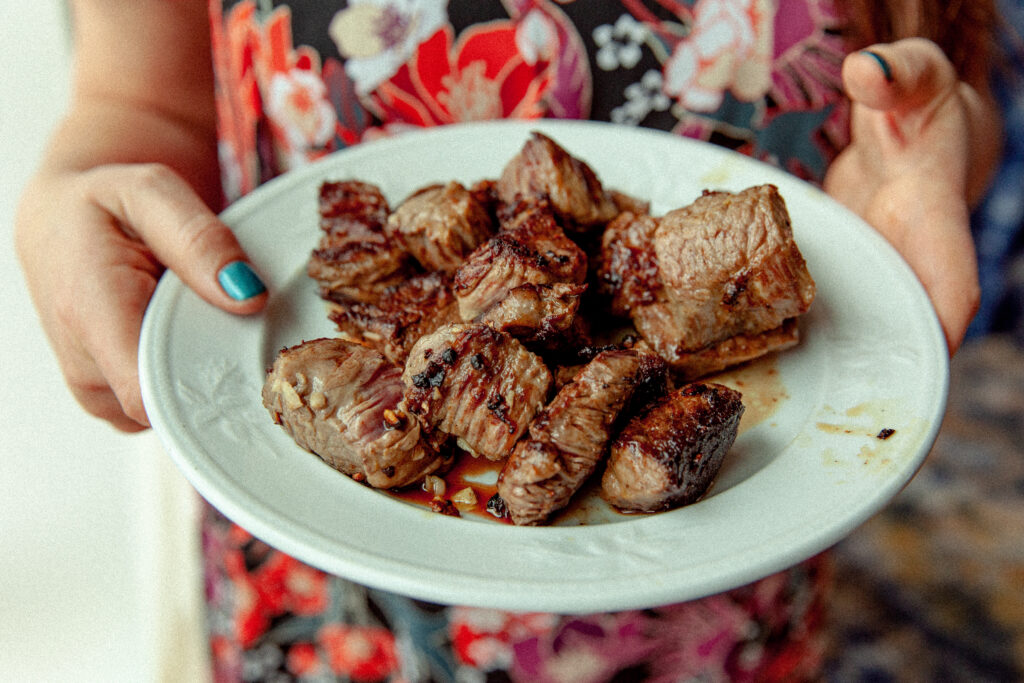
A character says of Mrs. Ramsay’s boeuf, “It was rich; it was tender. It was perfectly cooked. How did she manage these things in the depth of the country?” Photo by Erica Maclean.
The novel’s central thematic tension is explored through the painter Lily Briscoe, for whom making art is life’s central purpose, and Mrs. Ramsay, the hostess and mother of eight, for whom it’s marriage and family. Lily paints with a tortured intensity, striving to put what she sees on the canvas: “the shape of a white lamp-shade looming on a wicker table … roused one to perpetual combat.” Trapped in a society that believes women cannot or should not paint, she feels particularly oppressed and invalidated by Mrs. Ramsay, an archetype of Victorian womanhood, who appreciates art but has no urge to wander into the realm of image and abstraction. Instead, Mrs. Ramsay is constantly scheming to get Lily married: “Did that mean they would marry! Yes it must! What an admirable idea! They must marry!”
This is where the boeuf en daube comes in. The dish appears in a climactic scene as the emblem of Mrs. Ramsay’s domestic accomplishments. (Though, naturally, the actual preparation of the beef falls not to her but to the cook, Mildred.) A French preparation of stewed beef that was popular on English tables at the time, it can be flavored a la Provence, with tomatoes, olives, and capers, or with orange peel and cinnamon for a sweeter, more aromatic profile. In the novel, it’s Mrs. Ramsay’s grandmother’s recipe, and arrives buoyed by boat metaphors, suggesting a parallel between Mrs. Ramsay’s quest to serve dinner and her husband’s later mission to sail to the lighthouse. The group also eats from a “yellow and purple dish of fruit” arranged by one of the Ramsay daughters, which Mrs. Ramsay sees as “a trophy fetched from the bottom of the sea” that when “brought up suddenly into the light … seemed possessed of great size and depth.”
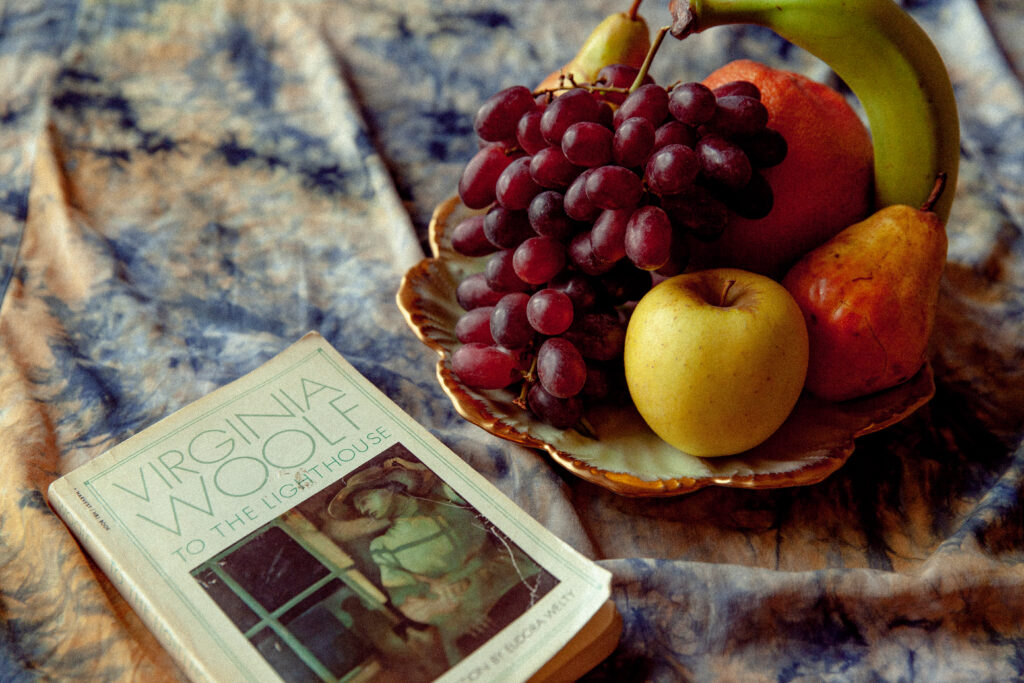
Mrs. Ramsay reflects that her guests see the fruit plate differently, “But looking together united them.” Photo by Erica Maclean.
These dishes are described with great fanfare but, as any competent home cook will know, beef stews are neither challenging to make nor impressive to look at. Although they cook slowly, the process is mostly hands-off. They do not require, as Woolf’s depiction would have it, a series of complicated steps that takes days. Some recipes call for an overnight marinade, but even that is not really necessary. And Mrs. Ramsay’s fear that the dish will be ruined if people are late to dinner is just as implausible. Stews can stay on the hob for hours, or be rewarmed when guests arrive, without detracting from the texture of the meat. I cooked a trial version for a full hour over the recommended time, continuing to add liquid, and the results were identical. I also heated up leftovers to no ill effect. Of my two attempts, both were delicious, but neither was something I’d choose to cook for a houseful of guests in the hope of a culinary triumph. In fact, in the recipe below, I couldn’t help myself, and added some technique-driven mashed potatoes in an effort to dress the dish up a bit.
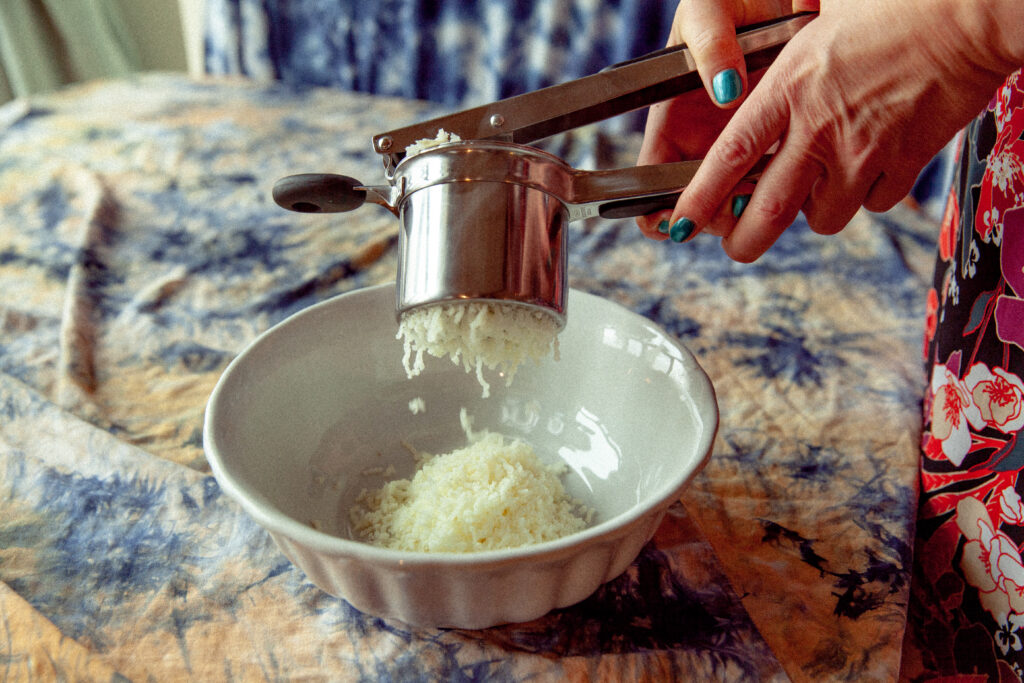
I am not a gadget person, but a ricer is indispensable for making ethereal mashed potatoes. Photo by Erica Maclean.
It’s surprising that Woolf, a writer who despaired when she couldn’t get the play of light and shadow on a lampshade just right, would be so sloppy in this one respect. It’s tempting to conclude that, in choosing such an unimpressive dish, she was somehow, obscurely, denying Mrs. Ramsay her moment. That suspicion is reinforced when, a few pages later, she savagely kills off the mother in a parenthetical. (One of the most powerful death scenes in all of literature, but I digress.) By this theory, Lily, a stand-in for Woolf and other like-minded women of her time, cannot make art while Mrs. Ramsay—representing Woolf’s mother and the Victorian virtues of femininity and domesticity—reigns supreme. The mother must die for Lily to finish her painting. In that case, can we really expect the artist to spend hours fiddling around in the kitchen, finding a dish that could truly burnish Mrs. Ramsay’s reputation as a hostess?
As a frequent thrower of house parties, I identify with the portrait of Mrs. Ramsay as the person responsible for creating an experience for everyone else. When the novel mentions towels “gritty with sand from bathing,” I wince with recognition: towel management is a primary feature of my summers. And I, too, plot my house-party meals days in advance, as you must if you want the food to be excellent and appear on time. At the meal where the boeuf en daube is served, Mrs. Ramsay sits down at the table and thinks, “But what have I done with my life?” It’s a question I frequently ask myself after some absurd feat of logistics involving, say, pancakes, bacon, sausage, and homemade rhubarb crumb cake, all served piping hot before 8 A.M. But I also know the answer to that question—and so did Woolf.
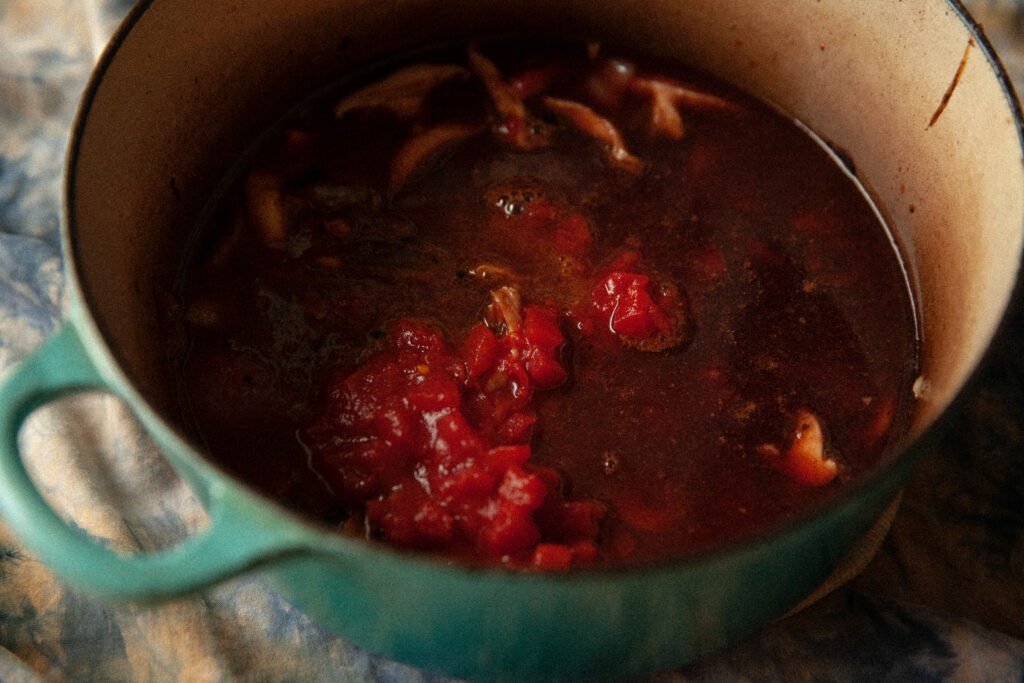
Browned meat, red wine and crushed tomatoes make a dish that is simple, but has memorable flavor. Photo by Erica Maclean.
Even if Woolf did feel some need to symbolically kill the mother-figure in service of her art, what she achieves in To the Lighthouse nonetheless does full honor to Mrs. Ramsay’s accomplishments. The woman she conjures is one who cherishes her eight children, her difficult husband, her damp, impossible house on the seashore, her intellectual and artistic guests. She is fifty years old and yet has such magnetism that the novel’s young men envision her “with stars in her eyes and veils in her hair, with cyclamen and wild violets.” And she exudes, most often, a radiant serenity. When Woolf writes that “[f]lashing her needles, confident, upright, she created drawing room and kitchen, set them all aglow,” we realize that Mrs. Ramsay is a creator as well, not of art but of life—the very thing others attempt, in their art, to capture. The novel may seem to level many charges against Mrs. Ramsay—the insistence that everyone should do as she does; the refusal to claim an independent identity—but she’s also the character allowed to reflect that “nothing on earth can equal this happiness.” Despite her sudden death, she seems undefeated by time.
So I prefer a different explanation for Woolf’s strange lapse with the boeuf en daube, one that came to me as I was wondering how to recreate the “savory confusion of brown and yellow” she describes. This, too, was impossible. Beef is brown or pink, not yellow, and anything cooked for hours in red wine will turn a uniform red. In the end, I decided that the dish must have been wrong for the same reason the Impressionists chose to paint bridges as blurs and faces as planes of light: to evoke the impression the thing produced was to draw closer to its essence. The beef is painted as Woolf painted everything, in search of its inner truth. In contemplating this Blake angel of a book, that seemed to me the likeliest explanation.
Boeuf en Daube
Adapted from the website Good Food Stories. Serves 4.
2 slices of bacon
1 1/4 lbs beef chuck, cubed, generously seasoned with salt and pepper, at room temperature
1/2 red onion, sliced
5 cloves garlic, minced
1 carrot, peeled and cut into coins
1 1/2 oz shiitake mushrooms
1 oz olives
1 1/2 tsp capers
1 14oz can crushed tomatoes
1 cup good-quality red wine
1/2 cup water
1 bay leaf
2 sprigs thyme
5 sprigs parsley
1/2 tsp peppercorns
Salt and pepper, to taste
Preheat the oven to 350.
Cook the bacon until crispy in a medium-sized Dutch oven. Remove and reserve. Turn the heat up to medium-high and brown the meat in batches, adding some olive oil if your bacon didn’t release enough grease. This is the step that develops flavor. You want enough room in the pan so the meat fries instead of steams. When one side is browned (and not before!) turn the meat with a fork to brown the other side. Remove the meat from the pan and set aside. Repeat until all the meat is browned.
Allow the pan to cool a bit, then the heat to medium-low, add the onion and fry until limp but not browned, about 5 minutes. Add the garlic and sauté until fragrant, about 2 minutes. Add the carrots, mushrooms, olives, and capers, and fry for a minute more. Add the crushed tomatoes, red wine, and water, and stir to scrape up any browned bits from the bottom of the pan. Turn the heat to high, and bring the mixture to a boil. Tie the bay leaf, thyme, parsley, and peppercorns in a bit of cheesecloth to make a bouquet garni, and add it to the pot. (Alternatively, just throw them in, but you’ll come across some stems and whole peppercorns in the finished dish.)
Return the bacon and the meat to the pan, cover, and place in the preheated oven. Cooking time is between three and four hours. Start checking at the 2 1/2 hour mark to make sure the liquid has not dried out. (If it has, add water). The dish is ready when the meat is falling apart fork-tender and all the fat has rendered out. Serve sprinkled with parsley.
Mashed Potatoes
Required implement: a potato ricer.
1 1/2 lbs potatoes
2 tbsp butter
3/4 tsp salt
1/4 cup heavy cream
1/4 cup milk
Bring a large pot of water to a boil. Add the potatoes, whole in their jackets, and boil until they can easily be pierced with a knife, about 20 minutes. Drain. When the potatoes are just cool enough to handle, peel them (the jackets should slip right off in your hands) and roughly chop. (Processing them while they’re still warm improves the consistency of the final mash). Put the potatoes through the potato ricer in batches, extruding them back into the pot. Add butter, salt, and heavy cream, and stir, turning the heat on low if you need help melting the butter. Different potatoes will absorb moisture differently, so continue to add milk 2 tbsp at a time until you’ve reached a loose, fluffy, cloud-like consistency. Taste and adjust for seasoning and consistency.
Copyright
© The Paris Review

